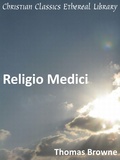Sir Thomas Browne
English physician and author
Biography
Browne was born in London, educated at Oxford and abroad, knighted (1671) by Charles II. His Religio Medici, in which Browne attempted to reconcile science and religion, was written about 1635. After circulating in manuscript, it was first published in a pirated edition (1642); an authorized edition followed (1643).
Inspired by the discovery of funeral urns near Norwich, he wrote Hydriotaphia: Urn Burial (1658), a solemn reflection on death and immortality, in which he expressed a belief in the futility of things here on earth. Published with Urn Burial was the more optimistic The Garden of Cyrus, a work devoted to the mystic symbolism of the number five. Browne’s philosophy is now primarily of historical interest. It is the quality of his faith and, particularly, his mode of expression that make him one of the outstanding figures in the history of English literature. His other notable works are Pseudodoxia Epidemica (1646), commonly known as Vulgar Errors, and Christian Morals (1716).


